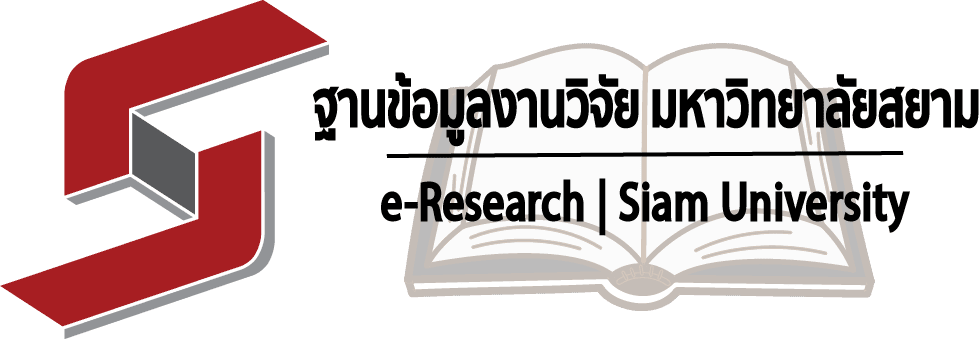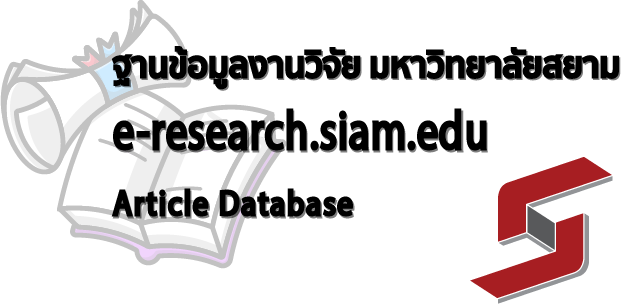- KB Home
- หลักสูตรระดับบัณฑิตศึกษา|Graduate Schools
- หลักสูตรปริญญาเอก|Doctoral Degree
- Ph.D. in Management
- ต้นแบบการบริหารจัดการเขตพัฒนาเศรษฐกิจพิเศษตาก
| หัวข้อวิทยานิพนธ์: Project Title: |
ต้นแบบการบริหารจัดการเขตพัฒนาเศรษฐกิจพิเศษตาก A management prototype of TAK Special Economic Development Zone |
| ชื่อนักศึกษา: Author: |
นางสาว สิรินพรรณ สุขใยพัธน์ * Ms. Sirinpan Sukyaipat |
| อาจารย์ที่ปรึกษา: Advisor: |
รองศาสตราจารย์ ดร. ปรีชา หงษ์ไกรเลิศ Associate Professor Dr.Pricha Hongskrailers |
| ระดับการศึกษา: Degree: |
ปรัชญาดุษฎีบัณฑิต (ปร.ด.) Doctor of Philosophy |
| สาขาวิชา: Major: |
การจัดการ Management |
| คณะ: Faculty: |
บัณฑิตวิทยาลัย Graduate Schools |
| ปีการศึกษา: Academic year: |
2560 2017 |
การอ้างอิง/citation
สิรินพรรณ สุขใยพัธน์. (2560). ต้นแบบการบริหารจัดการเขตพัฒนาเศรษฐกิจพิเศษตาก. (วิทยานิพนธ์ปรัชญาดุษฎีบัณฑิต). กรุงเทพฯ: บัณฑิตวิทยาลัย มหาวิทยาลัยสยาม.
บทคัดย่อ
งานวิจัยนี้มีวัตถุประสงค์เพื่อศึกษาต้นแบบการบริหารจัดการเขตพัฒนาเศรษฐกิจพิเศษตาก ประกอบด้วยข้อมูลเขตพัฒนาเศรษฐกิจพิเศษสงขลา เขตพัฒนาเศรษฐกิจพิเศษนครพนม และเขต เศรษฐกิจพิเศษในต่างประเทศ คือ จีน มาเลเซีย ฟิลิปปินส์ เพื่อวิเคราะห์และประเมิน โครงสร้างการ บริหารจัดการที่ประสบความสําเร็จหรือไม่สําเร็จ และเสนอโครงสร้างการบริหารจัดการต้นแบบที่ เหมาะสมกับเขตพัฒนาเศรษฐกิจพิเศษตาก รวมถึงการบริหารจัดการเพื่อให้ได้ประโยชน์สูงสุด การวิจัย ครั้งนี้เป็นเชิงคุณภาพ โดยการศึกษาข้อมูลจากเอกสาร การสัมภาษณ์ สัมภาษณ์เชิงลึกและการจัด สนทนากลุ่ม กับกลุ่มเป้าหมายในพื้นที่เขตพัฒนาเศรษฐกิจพิเศษตาก สงขลา และนครพนม ได้แก่ หน่วยงานภาคราชการ ภาคเอกชน องค์กรปกครองส่วนท้องถิ่น กลุ่มนักธุรกิจ ห้างร้านพ่อค้า และ ประชาชนในพื้นที่
ผลการวิจัยพบว่า พบว่า โครงสร้างเขตเศรษฐกิจพิเศษจีน, มาเลเซีย, ฟิลิปปินส์ เป็นโครงสร้าง องค์กรเขตเศรษฐกิจพิเศษที่เป็นทั้งภาครัฐทําหน้าที่เป็นผู้ดําเนินการทั้งหมดภาครัฐทําหน้าที่เป็นผู้กํากับ โดยเป็นผู้วางแผนจัดทํานโยบาย และภาครัฐทําหน้าที่เป็นผู้จัดการเขตเศรษฐกิจพิเศษที่มีกฎหมาย รับรองซึ่งมีความสําเร็จในบางกลุ่มธุรกิจ เมื่อวิเคราะห์ข้อมูลผลการศึกษาร่วมกับผู้เชี่ยวชาญในพื้นที่ สรุปได้ว่าโครงสร้างการบริหารจัดการเขตพัฒนาเศรษฐกิจพิเศษตาก ควรเป็นรูปแบบคณะกรรมการ 12 คน จากผู้ทรงคุณวุฒิจากหน่วยงานส่วนกลาง ผู้ทรงคุณวุฒิหน่วยงานในพื้นที่ ตัวแทนภาคเอกชน และ ตัวแทนภาคประชาชนพื้นที่โดยกําหนดแนวทางในการขับเคลื่อนแผนการพัฒนาพื้นที่ระยะเวลา 20 ปี โดย แบ่งเป็นระยะเวลา 2 ปี, 5 ปี, 10 ปี, 15 ปี, 20 ปี พร้อมระบบติดตาม ประเมินผล ร่วมกันพัฒนาจากความ คิดเห็นของ ผู้ที่เกี่ยวข้องเพื่อการปรับปรุงบรรลุผลสัมฤทธิ์ตามเป้าหมายที่กําหนด
Abstract
The objectives of this research were to study focused on Special Economic Development Zones in Thailand have been initiated for more than ten years; however, the implementation has not achieved the goal since the plans normally fell This qualitative research aimed to study the management model for Tak Special Economic Development Zone. The data were gathered from two different SEZs in Thailand including SEZ Songkla and SEZ Nakhorn Phanom. Relevant information was also collected from some other SEZs overseas namely: China, Malaysia and the Philippines. The data and information were then analyzed and evaluated, no matter whether the management was successful or not. Eventually, a possible structure that seemed to suit Tak Special Economic Development Zone was introduced, and a proper management model was formulated hopefully to get the most out of its newly adopted strategies. The fieldworks in SEZs Tak, Songkla and Nakhon Phanom were conducted via document exploring, in-depth interviews and discussions with stakeholders like the government authorities, private sectors, local administrative organizations, businesspeople, traders, and local citizens.
The study found that, the SEZ models in China, Malaysia, and the Philippines all apply the management structure that authorizes the government to completely control the whole operation process. They launch the plans and stipulate the policies performing as a legalized SEZ manager. This type of structure provides benefits for only some business groups. From data analysis with some experts in the area, it was recognized that in order to set up a successful SEZ management Model as TAK Special Economic Development Zone Authority (TSEZA), the basic management structure should consist of 12 committee members selected from experts in the central government authorities, local authorized units, private sectors and local citizens. The strategies and development plans should be extended throughout a period of 20 years during which sub plans are to be utilized ranging from 2 years, 5 years, 10 years, 15 years and 20 years respectively. Following-ups and assessments are also recommended to assure improvement and target achievement.
Keywords: Special economic zone, Economic development.
ต้นแบบการบริหารจัดการเขตพัฒนาเศรษฐกิจพิเศษตาก|A management prototype of TAK Special Economic Development Zone
Doctor of Philosophy in Management, Siam University, Bangkok, Thailand


